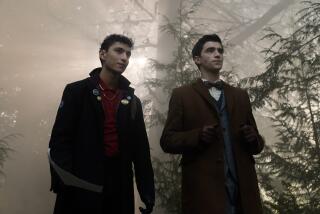TWO TV REVIEWS: ‘HEADROOM’ ON ABC; ‘GAY’ ON CBS
It’s a little late now to help ABC, but the network may have come up with the most exciting series of the season in “Max Headroom,” premiering tonight at 10 on Channels 7, 3, 10 and 42. Since Max is a man of the future, however, he’ll doubtlessly be willing to help ABC out next season.
Actually, Max isn’t a man at all. As fans of his British series (seen here on the Cinemax cable channel) and his U.S. commercials know, he’s an image of a man--a computerized reproduction with an electronic stutter, a wacky sense of humor and a massive ego.
“Want to check these ratings?” he asks shortly after appearing on a video monitor before a couple of humans. “I seem to have an audience of two!”
What a guy. Self-centered, shallow, glib, sarcastic, high-tech: He’s all ‘80s.
The premiere is easily the most original looking hour on TV this season. Set at some unspecified time in the future, it’s a combination of “Blade Runner” and “Mad Max,” full of sinister shadows, diffused neon, computer graphics and strange-looking people on the prowl. At the center of this pulsating world is Network 23, the leading television corporation in a competitive industry where ratings are spewed out instantaneously.
The hero is an investigative reporter, Edison Carter (Matt Frewer), who stumbles across a scandal at his own network. It seems that the company, in an effort to keep viewers from channel-hopping during commercials, has devised a way of compressing 30-second ads into three seconds. There’s just one catch: The spots cause couch potatoes to explode with information-overload.
There’s also one catch with this show. This is the same bizarre, tongue-in-cheek story that writer Steve Roberts and producer Peter Wagg used in the original “Max Headroom” show in Britain, depicting how Max came to be created in Carter’s likeness. Much of the dialogue has been recycled intact, as have the computer graphics. Roberts and Wagg are involved in the U.S. production, and so are the two leads from the earlier version--Matt Frewer as Carter and Max, Amanda Pays as Carter’s producer.
Final judgment, therefore, will have to be withheld to see what they come up with in subsequent episodes. Unlike the earlier series, in which Max went on to host his own talk show, ABC’s hourlong version will continue to be a drama, with Max helping his human counterpart uncover scandal and chicanery.
Roberts and Wagg, along with director Farhad Mann, cinematographer Bob Stevens and production designer Richard Lewis, may have raised standards higher than can be met on a weekly basis.
We’ll find out next week. In the meantime, as Max would say, we can h-h-h-hope that this series, like the product Max advertises, is the real th-th-th-thing.
Like “Max Headroom,” “What If I’m Gay?” arrives on CBS today with a cable-TV precedent. It’s not directly connected, as is the ABC series, but thematically it follows closely on the heels of “The Truth About Alex,” seen last month on HBO. Both concern teen-age athletes coming to the realization that they are gay.
Still, it’s a bold subject for CBS to be tackling in a “Schoolbreak Special” (3 p.m., Channels 2 and 8), particularly with the AIDS crisis that has engulfed the homosexual community. The health threat is dealt with in the hourlong drama, though rather glibly and not very honestly.
“If you’re responsible and you take the proper precautions, you don’t have to worry about that,” a counselor (Ed Marinaro) tells the troubled high school student (Richard J. Paul).
What is significant nonetheless is the attitude--approving. Writer Paul Cooper, producer Susan Aronson and director Jeff Brown realize that sexuality isn’t something defined by fear. Sexual activity may be, but not the feelings themselves. “What If I’m Gay?” is didactic and suffers for trying to compress what might be a months- or even years-long process into a few days, but it succeeds at its basic goals--to offer support to young men who may be grappling with their own homosexuality and to plead for understanding from their heterosexual peers.
More to Read
The complete guide to home viewing
Get Screen Gab for everything about the TV shows and streaming movies everyone’s talking about.
You may occasionally receive promotional content from the Los Angeles Times.






